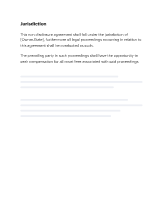Fill and Sign the Jury Instruction 332 Section 1 Per Se Violation Tying Agreement Defense of Justification Form

Practical advice on preparing your ‘Jury Instruction 332 Section 1 Per Se Violation Tying Agreement Defense Of Justification’ online
Are you exhausted from the inconvenience of handling paperwork? Look no further than airSlate SignNow, the premier electronic signature platform for individuals and businesses. Bid farewell to the time-consuming tasks of printing and scanning documents. With airSlate SignNow, you can seamlessly complete and sign paperwork online. Take advantage of the powerful tools integrated into this straightforward and affordable platform and transform your approach to document handling. Whether you need to approve forms or gather eSignatures, airSlate SignNow manages everything easily, with just a few clicks.
Follow these comprehensive steps:
- Access your account or register for a complimentary trial with our service.
- Click +Create to upload a document from your device, cloud storage, or our form library.
- Open your ‘Jury Instruction 332 Section 1 Per Se Violation Tying Agreement Defense Of Justification’ in the editor.
- Click Me (Fill Out Now) to set up the form on your end.
- Add and designate fillable fields for others (if needed).
- Continue with the Send Invite settings to solicit eSignatures from others.
- Download, print your copy, or convert it into a reusable template.
No need to stress if you want to collaborate with your colleagues on your Jury Instruction 332 Section 1 Per Se Violation Tying Agreement Defense Of Justification or send it for notarization—our platform provides you with everything you require to accomplish such tasks. Register with airSlate SignNow today and elevate your document management to a new level!
FAQs
-
What is the significance of Jury Instruction 3 3 2 Section 1, Per Se Violation Tying Agreement Defense Of Justification?
The Jury Instruction 3 3 2 Section 1, Per Se Violation Tying Agreement Defense Of Justification is crucial in legal contexts as it outlines the standards for evaluating whether a tying arrangement constitutes a violation. Understanding this instruction helps legal professionals effectively argue cases involving anti-competitive practices. airSlate SignNow supports legal documentation processes by ensuring that such important legal concepts are easily accessible and can be efficiently managed.
-
How does airSlate SignNow help with legal documents related to Jury Instruction 3 3 2 Section 1?
airSlate SignNow streamlines the process of creating, sending, and signing legal documents that reference Jury Instruction 3 3 2 Section 1, Per Se Violation Tying Agreement Defense Of Justification. Our platform allows users to customize templates that specifically address these legal standards, ensuring compliance and clarity in legal communication. This efficiency can save valuable time in preparing legal documentation.
-
Is airSlate SignNow affordable for small law firms dealing with Jury Instruction 3 3 2 Section 1 cases?
Yes, airSlate SignNow offers competitive pricing plans that are designed to be budget-friendly for small law firms handling cases involving Jury Instruction 3 3 2 Section 1, Per Se Violation Tying Agreement Defense Of Justification. With various subscription options, firms can choose a plan that fits their needs without compromising on essential features. This affordability allows small practices to leverage powerful e-signature solutions without breaking the bank.
-
What features does airSlate SignNow provide for managing documents related to Jury Instruction 3 3 2 Section 1?
airSlate SignNow includes features such as customizable templates, secure e-signatures, and comprehensive document tracking, which are vital for managing documents related to Jury Instruction 3 3 2 Section 1, Per Se Violation Tying Agreement Defense Of Justification. These features ensure that legal professionals can efficiently create, distribute, and monitor the status of critical documents, enhancing productivity and compliance.
-
Can airSlate SignNow integrate with other legal tools for cases involving Jury Instruction 3 3 2 Section 1?
Absolutely! airSlate SignNow integrates seamlessly with various legal tools and software, allowing for a cohesive workflow when dealing with cases involving Jury Instruction 3 3 2 Section 1, Per Se Violation Tying Agreement Defense Of Justification. This integration capability ensures that all aspects of case management are streamlined, making it easier for legal teams to collaborate and maintain organization.
-
What are the benefits of using airSlate SignNow for legal documents related to Jury Instruction 3 3 2 Section 1?
Using airSlate SignNow for legal documents pertaining to Jury Instruction 3 3 2 Section 1, Per Se Violation Tying Agreement Defense Of Justification offers numerous benefits, including increased efficiency, enhanced security, and simplified collaboration. Legal professionals can quickly send and receive signed documents, reducing turnaround time and improving client satisfaction. The platform's intuitive design makes it easy for users of all skill levels to navigate.
-
How secure is airSlate SignNow for documents involving Jury Instruction 3 3 2 Section 1?
Security is a top priority at airSlate SignNow, especially for documents related to sensitive legal matters like Jury Instruction 3 3 2 Section 1, Per Se Violation Tying Agreement Defense Of Justification. Our platform employs advanced encryption protocols and complies with industry standards to ensure that all documents are protected from unauthorized access. Users can confidently manage their legal documents, knowing they are secure.
Related searches to jury instruction 332 section 1 per se violation tying agreement defense of justification form
The best way to complete and sign your jury instruction 332 section 1 per se violation tying agreement defense of justification form
Find out other jury instruction 332 section 1 per se violation tying agreement defense of justification form
- Close deals faster
- Improve productivity
- Delight customers
- Increase revenue
- Save time & money
- Reduce payment cycles















